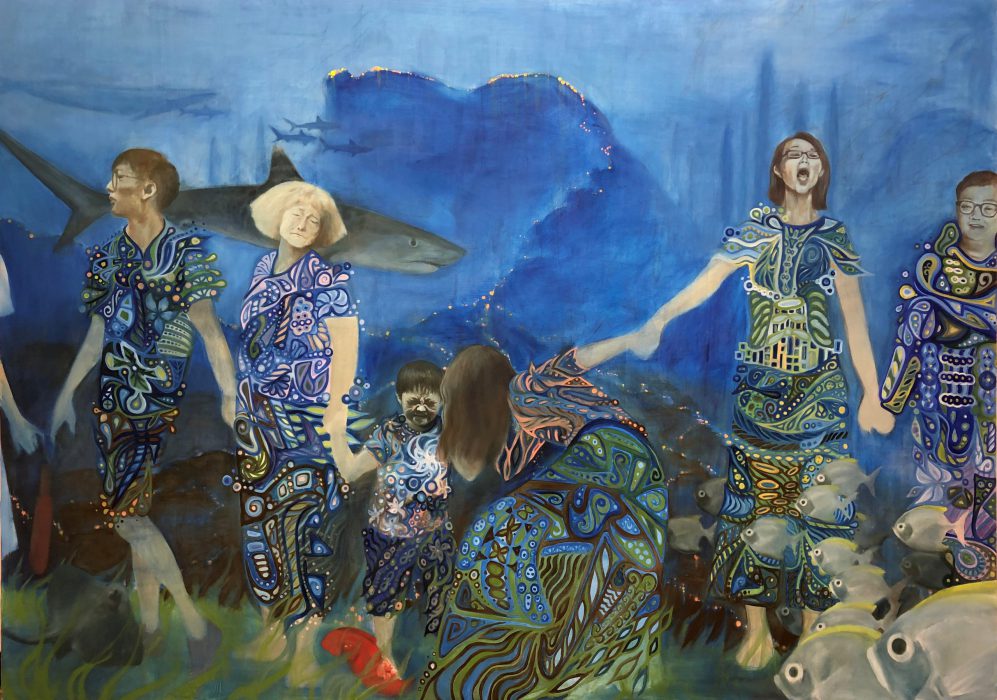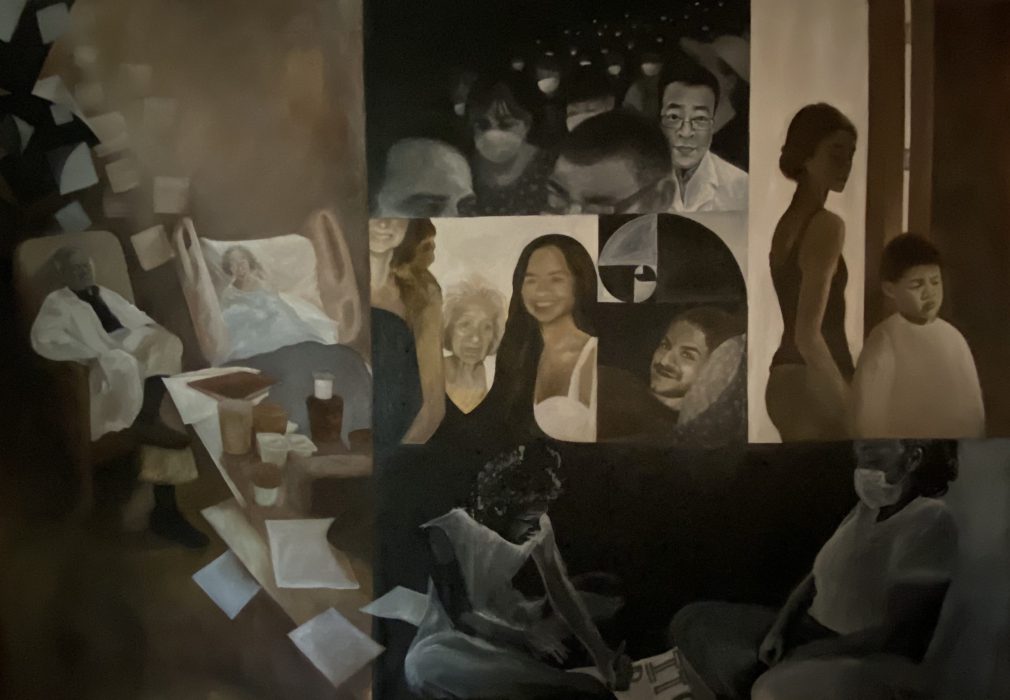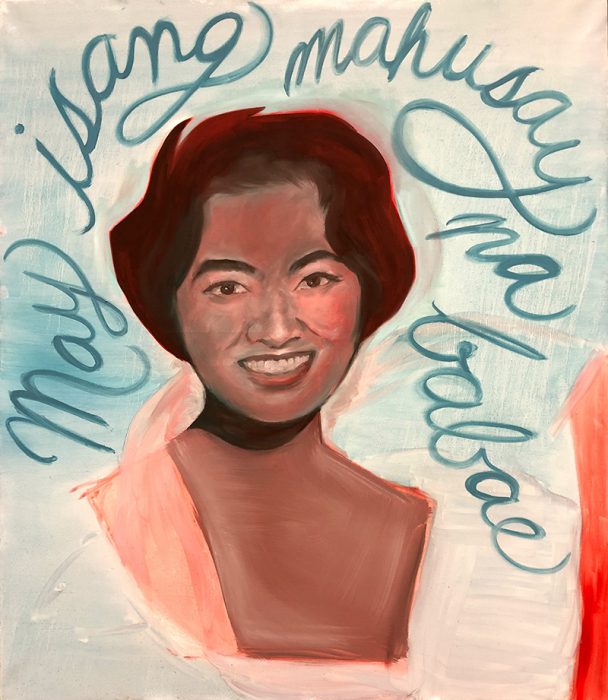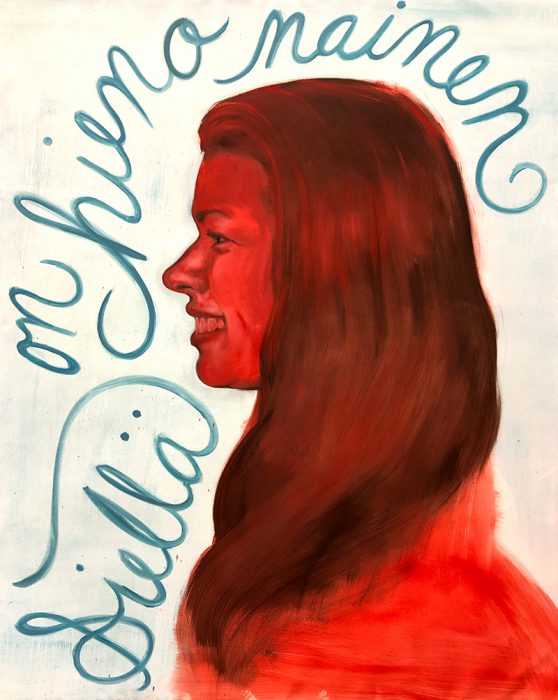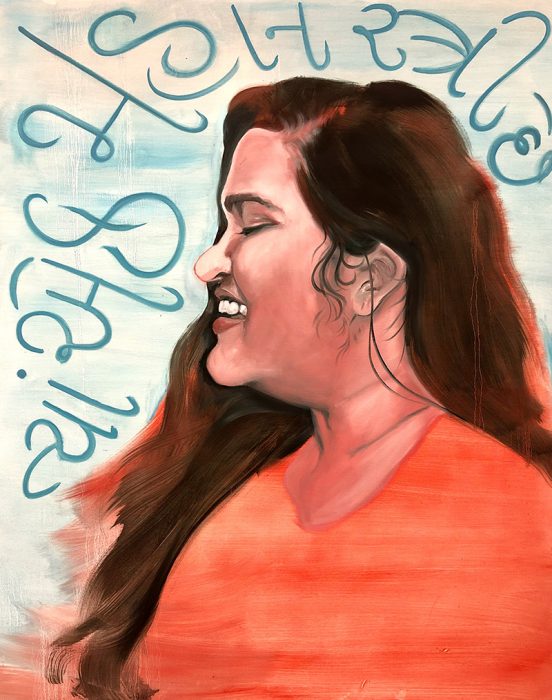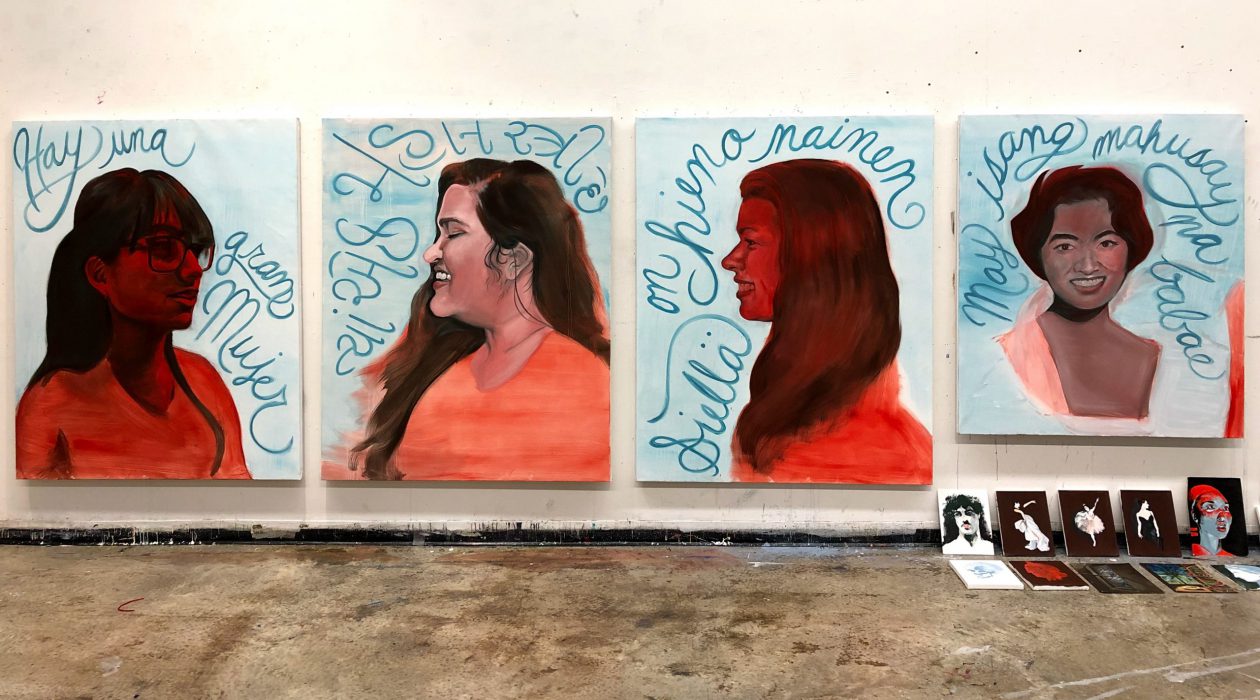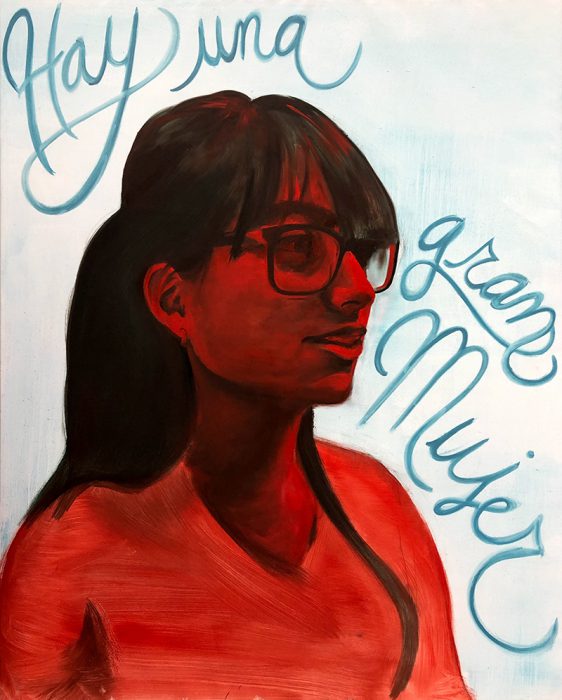Michaela Lozada
Alavida, March 2020 – September 2020, Oil painting on canvas, over 10 feet wide and over 8 feet high (89.25′′ x 125.25′′), See more here: https://photos.app.goo.gl/XfUi2ntxAZ2wx47aA
In March of the year 2020, we moved as one in mass exodus – from our living spaces, from our occupations, from our routines, and, most notably, from each other. This was a global phenomenon not unique to our community, yielding a moment in human history which is inarguably anomalous. When future generations ask me what it was like to live during this moment in history – which they will ask – what will I tell them?
This is the question which fueled my actions immediately following the onslaught of
COVID-19. When I moved back in to my childhood home after abandoning my adult life, I wasted no time in upturning the order of my old bedroom, moving furniture and clearing out everything I could do without in order to turn my largest wall and the surrounding area into my new studio. I hung as large of a cutting of unstretched duck canvas cloth on this wall as I could and primed my new surface in my new makeshift studio, standing on cheap plastic tarp and scooping gesso from a tupperware. Six months later in September, I had completed the largest painting I had ever undertaken. My driving mission was to create a representation of the spirit of this time in history.
My subjects are figures, both human and geometric. I make reference to the famous golden Fibonacci spiral, using the form as a compositional “scaffold.” This scaffold holds up my construction of a series of square cells, each cell containing a figure or figures. I set about trying to represent a range of ages, genders, ethnicities, and personalities so expansive that every human on Earth could view this work and relate to at least one figure – this is a global experience, after all.
We are all spiraling together, united in an escalating, viral situation to which every human is susceptible, yet which is beyond any human’s control. To make matters worse, we are a house divided – we have been divided into disparate houses, rooms, cells, for our own safekeeping. In a bizarre twist, cells are also the only medium through which we are now permitted to connect with each other – in the form of digital screens, Facetime boxes, Zoom galleries, Webex panels, etc.
So, to address the aforementioned question – “What is it like to live during this moment in history?” – I provide as my answer Alavida, a painting in direct response to the historical six-month period during which it was born, grown, and completed by me, Michaela Jane Lozada, one of many displaced and isolated artists. History is written by those who experience it – I submit this painting to the “Remaking Histories” exhibition because of the crucial role it plays in making histories as our history is being remade before our eyes.
I credit the title Alavida to my Filipina Grandma Luds: it means “still alive.”
Human Chain, August 2019 – December 2019, Oil painting on canvas stretched on wood, over 10 feet wide and over 7 feet high (89.25′′ x 125.25′′) Read and see more here: http://michaelalozada.net
I began building this over 8’ x 10’ canvas in August; I did not begin painting it until mid-October. I kept changing the idea for my composition as I heard more and as the situation escalated in Hong Kong. I always wanted to utilize the beauty of nature to imbue a sense of hope into the image I was going to make, but it was very difficult to figure out how. It was after I had seen the image of the incredible human chain formed on Lion Rock Mountain in September of 2019 that I decided I wanted to feature the image of the human chain. Even then, I continued to let the painting develop without a strict “plan” – for example, I didn’t decide to integrate the five demands into the characters’ bodies until November or December, as I thought more and more about the intolerable cost of living without such basic rights.
In the painting itself, I crafted my “characters” to represent a wide array of ages and personalities which can be found amongst members of this movement. I used public images of Hong Kongers found online as inspiration, but I did not try to copy any single individual’s face exactly – none of them are based on any real person. (The face of the central little boy is contorted because his character is based off of the image of a toddler who was subjected to tear gas by the Chinese police.) I also want to note that I have hidden all of the leftmost figure except for the edges of a generic school uniform, in respect of all of the students who risk everything with a courage and maturity which is beyond their years. It’s very important to note that, as mentioned before, the characters’ bodies literally carry the meaning of their fight. The patterns on the five adult characters are abstractions of the Chinese characters representing the five demands of the protest movement which protestors stand for. The little boy was the first figure to whom I added the patterns. I wanted his to be the simplest of the patterns, and yet the most vital to the group – so over his heart, I placed the white flower of the Hong Kong flag.
In order to also convey a sense that my characters have been standing in their chain for a very long time, I added patterns to these characters to allow them to resemble growths of algae and corals. I also painted the figure’s faces and limbs to appear almost calcified – perhaps even turning to stone – and I permit the distinction between the ocean and their bodies to disappear in many places.
I have also included a more hidden sign to imply how long my characters have been standing. The little boy and maternal figure stooping over him in the center of the painting are echoed to the left, in the young adult male holding the hand of the older woman – another son-mother relationship. This repetition conveys many questions: Are the two individuals on the left the very same son-mother pair, still standing in their same place for the same reasons, even after so many years? Or are they two different pairs? For how many generations has this chain been standing? For how many more will they – must they – stand?
I connect the two leftmost figures with an umbrella, rather than by directly held hands. This is of course a nod to the Umbrella Movement, but it is also a salute to the involvement of the youth of Hong Kong in the protest. In Hong Kong, it is socially frowned upon for young people to touch members of the opposite sex, so students have come up with a means to form human chains by holding onto opposite end of various objects. I have hidden all of the leftmost figure except for the edges of a generic school uniform, in respect of all of the students who risk everything with a courage and maturity which is beyond their years. Notably, I also include an outline of Lion Rock, the mountain where protestors formed a human chain of history-making length in September of 2019.
The imagery of the painting can also be related to many others in other countries who have had to stand for basic human rights which have unjustly been made unavailable to them. (The pro-democracy movement in Hong Kong has even helped to inspire many other protest movements abroad.) There is also a universal connection in the statement of the human chain, which I have painted to call attention to injustice and suffering in a hopeful way. I want to use painting to convey the following:
- The protestor’s hope for a better future, and
- The reserved but commanding power that can be produced through peaceful, non- violent means of protest.
I know that this painting reflects the fullest meaning of the spirit of “Remaking Histories” – in fact, it could not be a more desperate vision of a better history that the one which is currently unfolding overseas in Hong Kong. I would be honored if Human Chain could contribute to this exhibit, and my greatest hope is that it brings my vision of a more peaceful, tolerant history and a broader perspective to new audiences.
Behind Every Great Country, March 2018, Each of the paintings in this series is about 4’ x 5’, created in oil paint on self-stretched, self-built canvases. Read and see more here: http://michaelalozada.net
Have you ever heard that old saying, “Behind every great man is a great woman?”
Each of the paintings in this series is about 4’ x 5’, created in oil paint on self-stretched, self-built canvases.
On each painting, “There is a great woman” is written in the languages of each woman’s motherland, including Philippines, Finland, India, and Colombia: Tagalog, Finnish, Gujarati, and Spanish. I only ever used red, white, blue, or Pthalo blue. I also only used white in two of them, so that when they are displayed, they recall red and white stripes.
This series is a celebration of what women, and in particular, women from all nations, have contributed to the United States of America. Like the original saying, “behind every great man is a great woman” was commandeered to empower women (ironic considering its original undertones), I now use the phrase “behind every great country is a great woman” and presidential portraits of ordinary-yet-extraordinary women to recognize their immeasurable and underestimated Grit.
This series speaks to the history of American women and of immigrants, attracting the viewer’s attention to sidelined stories which are not often told. The paintings represent the theme of
“Remaking Histories” in its bold recognition of the quiet power of females and immigrants, individuals who have an undeniable history of breathtaking accomplishments which have an equally undeniable history of being overlooked in the teaching of history in so many classrooms and textbooks mass-published and distributed across the United States.
